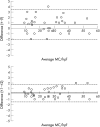Diarrhoea-predominant IBS patients show mast cell activation and hyperplasia in the jejunum
- PMID: 17005763
- PMCID: PMC1856785
- DOI: 10.1136/gut.2006.100594
Diarrhoea-predominant IBS patients show mast cell activation and hyperplasia in the jejunum
Abstract
Background: Increased numbers of mast cells and mast cell activation in distal gut segments are associated with symptom onset and severity in irritable bowel syndrome (IBS). Although upper gut symptoms are common, mast cells have not been thoroughly evaluated in proximal gut in IBS patients.
Methods: Jejunal biopsies obtained by Watson's capsule, aspiration of intestinal fluid and one blood sample were obtained in 20 diarrhoea-predominant patients with IBS (D-IBS) and 14 healthy volunteers (H). Psychological stress (Holmes-Rahe Scale) and depression (Beck's Depression Inventory) were evaluated at baseline and food and respiratory allergy excluded. Biopsies were processed for H&E staining and microscopic inflammation assessed by counting intraepithelial lymphocytes. Mast cells in lamina propria were counted by immunohistochemistry with CD117 (c-kit). Tryptase concentration was measured in intestinal fluid and serum.
Results: D-IBS patients showed higher psychological stress than healthy volunteers (D-IBS: 203 (SD 114) v H: 112 (SD 99); p = 0.019). Immunohistochemical staining of jejunal mucosa revealed mild increase in intraepithelial CD3+ cells in D-IBS patients (D-IBS: 15.3 (SD 5.5; 95% CI 12.7 to 17.9) v H: 10.3 (SD 3.9; 95% CI 8.0 to 12.5); p = 0.006). Moreover, D-IBS patients showed marked increase in mast cells numbers (D-IBS: 34 (SD 9.3); H: 15.3 (SD 4.4) mast cells/hpf; p<0.001) and higher tryptase concentration in jejunal fluid (D-IBS: 0.45 (SD 0.38); H: 0.09 (SD 0.10) microg/l; p = 0.005). Upper gut symptoms were not associated with gender, mast cell counts, jejunal tryptase or basal stress.
Conclusion: This jejunal mucosal inflammatory profile may help identify diarrhoea-predominant IBS, a stress-related disorder.
Conflict of interest statement
Competing interests: None.
Similar articles
-
Diarrhoea-predominant irritable bowel syndrome: an organic disorder with structural abnormalities in the jejunal epithelial barrier.Gut. 2013 Aug;62(8):1160-8. doi: 10.1136/gutjnl-2012-302093. Epub 2012 May 25. Gut. 2013. PMID: 22637702
-
Intestinal serotonin release, sensory neuron activation, and abdominal pain in irritable bowel syndrome.Am J Gastroenterol. 2011 Jul;106(7):1290-8. doi: 10.1038/ajg.2011.86. Epub 2011 Mar 22. Am J Gastroenterol. 2011. PMID: 21427712
-
Increased humoral immunity in the jejunum of diarrhoea-predominant irritable bowel syndrome associated with clinical manifestations.Gut. 2015 Sep;64(9):1379-88. doi: 10.1136/gutjnl-2013-306236. Epub 2014 Sep 10. Gut. 2015. PMID: 25209656
-
Stress and the gut: pathophysiology, clinical consequences, diagnostic approach and treatment options.J Physiol Pharmacol. 2011 Dec;62(6):591-9. J Physiol Pharmacol. 2011. PMID: 22314561 Review.
-
Mast cells are increased in the small intestinal mucosa of patients with irritable bowel syndrome: A systematic review and meta-analysis.Neurogastroenterol Motil. 2019 Dec;31(12):e13718. doi: 10.1111/nmo.13718. Epub 2019 Sep 9. Neurogastroenterol Motil. 2019. PMID: 31498961
Cited by
-
The role of colonic mast cells and myenteric plexitis in patients with diverticular disease.Int J Colorectal Dis. 2013 Feb;28(2):267-72. doi: 10.1007/s00384-012-1554-z. Epub 2012 Aug 5. Int J Colorectal Dis. 2013. PMID: 22864621
-
Intestinal anti-inflammatory and visceral analgesic effects of a Serpylli herba extract in an experimental model of irritable bowel syndrome in rats.Front Pharmacol. 2022 Sep 2;13:967644. doi: 10.3389/fphar.2022.967644. eCollection 2022. Front Pharmacol. 2022. PMID: 36120292 Free PMC article.
-
Mucosal Plasma Cell Activation and Proximity to Nerve Fibres Are Associated with Glycocalyx Reduction in Diarrhoea-Predominant Irritable Bowel Syndrome: Jejunal Barrier Alterations Underlying Clinical Manifestations.Cells. 2022 Jun 28;11(13):2046. doi: 10.3390/cells11132046. Cells. 2022. PMID: 35805133 Free PMC article.
-
Mast cells in gastrointestinal disease.Gastroenterol Hepatol (N Y). 2010 Dec;6(12):772-7. Gastroenterol Hepatol (N Y). 2010. PMID: 21301631 Free PMC article.
-
Post-infectious irritable bowel syndrome: mechanistic insights into chronic disturbances following enteric infection.World J Gastroenterol. 2014 Apr 14;20(14):3976-85. doi: 10.3748/wjg.v20.i14.3976. World J Gastroenterol. 2014. PMID: 24744587 Free PMC article. Review.
References
-
- Horwitz B J, Fisher R S. The irritable bowel syndrome. N Engl J Med 20013441846–1850. - PubMed
-
- Bercik P, Verdu E F, Collins S M. Is irritable bowel syndrome a low‐grade inflammatory bowel disease? Gastroenterol Clin N Am 200534235–245. - PubMed
-
- Talley N J, Spiller R. Irritable bowel syndrome: a little understood organic bowel disease? Lancet 2002360555–564. - PubMed
-
- Palsson O S, Drossman D A. Psychiatric and psychological dysfunction in irritable bowel syndrome and the role of psychological treatments. Gastroenterol Clin N Am 200534281–303. - PubMed
Publication types
MeSH terms
Substances
LinkOut - more resources
Full Text Sources
Other Literature Sources
Medical







